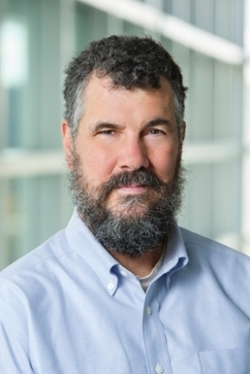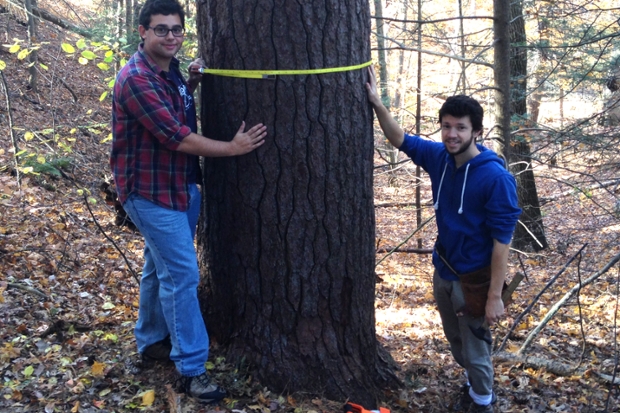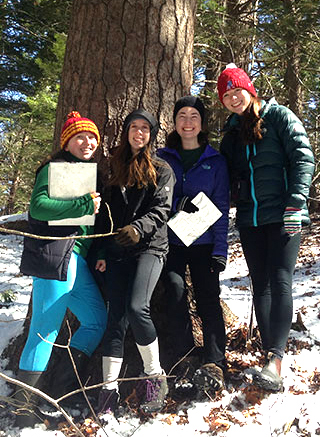Eastern Hemlock trees are all but gone. This farmer/professor is doing something about it—with his students
Brian Donahue and his students are trying to protect the eastern hemlock, one tree at a time

Brian Donahue
As the climate warms, New England forest species face increasing threats of changing temperature, precipitation and invasive threats. Associate professor of American environmental studies Brian Donahue ’82, PhD ’95, and his students are working to keep Massachusetts forests from losing some species that forests farther south have already lost.
Donahue and the undergraduates who are participating in his research are mapping hemlocks in the forests in Concord, Lincoln, and Weston to help local conservation commissions decide how to manage these threatened trees.
Hemlocks in Massachusetts are under threat because of a sap-sucking insect called the hemlock woolly adelgid, which has already devastated hemlocks from North Carolina to Connecticut.
The insects move north as the climate warms. Periodically, Donahue and a group of his students return to the woods to collect data on tree species and size, as well as understory vegetation and coarse woody debris on the forest floor.
Some students are carrying the work forward after graduation. Molly Cahill ’18, a former student of Donahue’s, is a research crew leader at Harvard Forest, running a program that places students in the field and in research office settings.
Donahue has been farming since 1975, when he interrupted his undergraduate studies at Brandeis to work on a community farm. He started another community farm that he ran after returning to Brandeis to finish his bachelor’s degree and go on to his PhD in history – a process that took 13 years as he worked the farm and became a scholar. BrandeisNOW asked Donahue about his latest work on protecting New England’s forests.

David Chernak ’17 (left) and Mike Devito ’16 measure a hemlock to show growth
How did you get involved with the hemlock project?
Six or seven years ago I started a program with Harvard called the Sustainable Working Landscapes group where Brandeis undergraduate students go out in the woods and do research on changes in the forest. We look at long-term changes in the forest, and at the impact of species such as hemlock woolly adelgid and white-tailed deer. We have a grant from the Thoreau Foundation to support Brandeis undergraduates as field assistants to gather this data, and we collaborate with Harvard Forest in this ecological work.
What have you learned from your observations?
Over time, we hope to use our research to help conservation organizations in these towns get a grasp of how their lands are changing and how they might want to manage them: For example, should they treat hemlock trees and try to hold off the hemlock woolly adelgid, or just let it go? Should they allow deer hunting?
How is climate change affecting the hemlocks?
There’s an aphid-like insect (the woolly adelgid) that has been spreading from Virginia since the 1950s. It comes from Japan, originally. And it kills Eastern hemlocks. A lot of Eastern hemlocks have been lost, but it's limited somewhat by winter cold. And we're right at the edge of where it's currently limited here in Massachusetts. In Connecticut, most of the hemlocks are gone. In Lincoln and Weston, we focus on several beautiful hemlock stands to see what's happening. We have the adelgid, but so far, many of the trees are surviving—although that may not last.

Rebecca Mitchell ’16, Stacy Carter '15, Molly Cahill ’18, and Maggie Hensel ’16
Do local officials use your research?
Yes. In both Lincoln and Weston, the conservation commissions chose to treat some of their nicest hemlocks to knock back the adelgid. Students are helping monitoring those stands to help the commissions decide if and when they might want to treat them again, and also to compare them to untreated stands. The hope is to keep the trees alive until some kind of natural predator can be introduced to combat the adelgid.
Students also study changes in deer population and the impact on deer browse, the twigs and woody plants that deer depend on in the winter. Impacts can be quite severe. Conservation landowners have to decide whether or not to introduce bow hunting to try to control the deer, which can be controversial. We can’t make that decision for them, but with our students doing research in the forests, we can at least provide a better understanding of what’s going on out there.
Categories: Research, Science and Technology, Student Life





